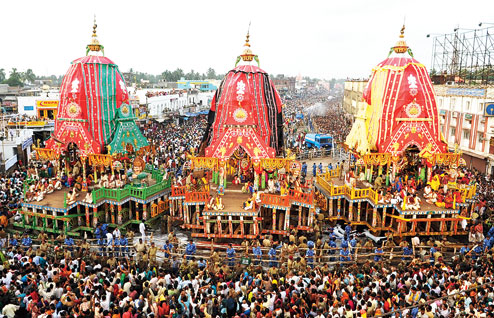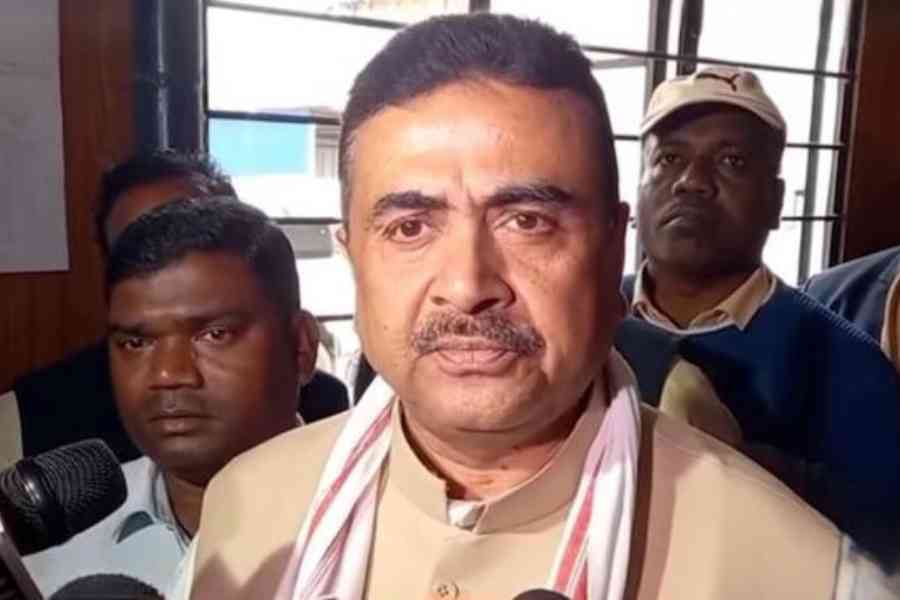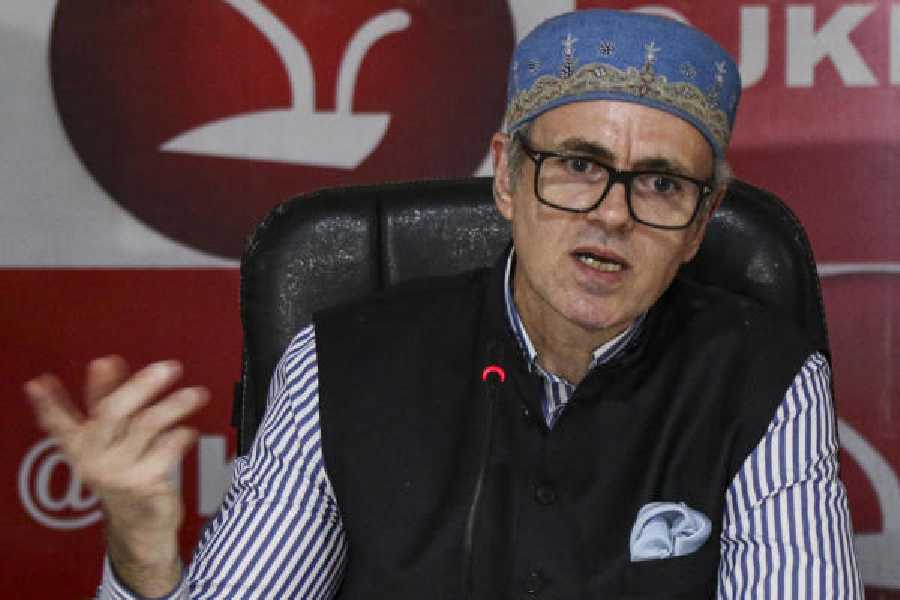
Lord Jagannath, it is said, is an embodiment of Param Bramha or the complete concentration of all the powers on Earth. Bramha is the ultimate mystique on earth. Hinduism or Vedantism, as Swami Vivekananda used to call it, is perhaps the only religion where the Bramha is worshipped directly.
Truncated idol: the reasons why
The noted poet Tulsidas once visited Puri in search of his Raghunath (Lord Rama). After completing his darshan of Lord Jagannath, he was extremely disappointed with the appearance of the deity. He was so sad that he walked away and kept walking until he reached a village called Malatipathpur. There he sat down under a tree crying. Soon a boy came up and asked him the reason for his agony. The poet explained to the boy that his Raghunath, whom he loved so dearly, had actually eluded him at Puri and that he was non-existent in what he saw at the temple. The boy is said to have reminded the poet of one of his own verses, in which he describes his Raghunath as an offshoot of Param Bramha, who can move without feet, see without eyes and listen without ears. (“bina pada chale”, “bina aankh dekhe”, “bina kaan suney”). It was then that Tulsidas realised his folly and rushed back to Puri to find his Raghunath.
This explains why Jagannath has no ears, no hands and no feet. But such an unassuming look of the idols especially in Odisha, where even the smallest of temples has deities that are nothing short of works of art, also begs a sociological explanation.
Blue turns to black

A possible explanation is as follows. The temple was originally presided over by a Vishnu statue with four hands holding the signature shankha, chakra, gada, padma (conch, wheel, mace and the lotus) made of blue sapphire (neelam), hence the name Neela Madhab. Jagannath is worshipped even today as Neela Madhab.
This temple was attacked many times during the Mughal rule, as also later on, by Kalapahar, the 16th century marauder. The idol was badly damaged many times. The king of Puri then took a decision to replace it with something that can be recreated time and again, no matter how many times it gets destroyed. The new statue is an example of tribal art possibly borrowed from nearby villages. This art form has a strong Buddhist influence, as the time of the king’s decision was possibly around the 16th century.
The temple was originally built in the 12th century, much after Ashoka’s Kalinga conquest. Jagannath, Balbhadra and Subhadra are daru idols, or, made from Neem wood. The possible reason why neem was used could be its resistance to all kinds of decay. The idols are religiously embalmed with sandal paste. The medicinal properties of sandal fortifies the idols against any fungal growth and also makes for a soothing aroma around the garvagriha (the sanctum sanctorum).
Change of the lord’s body
The year 2015 is special for it is the year of the Naba Kalebar, when the Lord changes his body. This occurs every 19 years. It is in this year that the Bramha, which is lodged inside the old statue is shifted to the new one. There is a superstition that the person who performs the ritual passes away and mingles with the Lord in less than a year’s time.
No one knows what the “soul”, transferred from inside one idol to the other in darkness, is. Some old-timers of Puri say that it is believed that the Bramha is actually the asthi (funeral remains) of Lord Buddha.
The old idols of Jagannath, Balabhadra and Subhadra are buried inside the temple at “Koili Baikuntha”. People hold the mud in which the burial takes place to be of divine value. They trust that this mud helps them in hours of need.
The rituals of the temple, as of now, follows the Vaishnav traits, but according to scholars, Vaishnavism and Jagannathism have differences. While Vaishnavism is traditionally about the conjugal, metaphysical love of Lord Krishna and Sri Radhika, Jagannathism is actually Universal Brotherhood, wherein two brothers stand in guard for their sister.
The farmer and the king
The philosophy of Jagannathism follows socio-economic traditions of India. Though Jagannath’s black hue is analogous to that of Lord Krishna, he actually represents the common farmer on the field who gets tanned by exposure to the scorching heat. Balabhadra, on the other hand, represents the blue-blooded king with a fair glow on his face, Subhadra epitomises the common woman who spends most of the day beside the hearth, and hence her yellow look.
This classification is also evident from the food that is offered to the deities. Lord Jagannath takes coarse brown rice with bland vegetables and lentils. This is because a large section of the common people in India suffer from acidity and stomach ailments. He ends His day with Dahi Pakhala (fermented rice with curd), which is traditionally taken by farmers to beat the heat and to sleep soundly at night. Lord Balabhadra generally takes Kanika (fine rice with ghee and dry fruits), as does Subhadra who takes food doused heavily with spices and chillies (akin to the food habits of an Indian woman).
The non-vegetarian link
Any visit to Lord Jagannath is incomplete without a visit to Ma Bimala’s temple in the south-west corner of the inner enclosure of the temple complex. Here comes a Shakta twist in the tale. Because of her, Lord Jagannath is worshipped the Shakta way also. Ma Bimala is non-vegetarian but the Lord a strict vegetarian.
That makes for a contradiction. Ma Bimala is the resident deity of what is counted as one of the 108 upapithas of Shakti. In this worship, the Lord becomes the Bhairav and Bimala, the Bhairavi. Any food offered to Lord Jagannath is only prasad, as long as it’s not offered to Ma Bimala. Only when it is offered to Bimala does it become mahaprasad.
During Durga puja, Bimala is offered non-vegetarian food and animal sacrifice is held in her name. The goddess is supposed to assume a destructive form during the festival and meat is considered necessary to placate her.
Actually, Shakti gives one the power to endure pain and love selflessly — the basis of Vaishnavism. The power to win over anger and lust is what forms the essence of the Vaishnav cult. Thus Shakti has to precede Vaishnavism and succeed Shaivism, which leads to new creations.
Climb of faith

Have you ever witnessed the daily changing of the flag atop the temple mast at Puri? The flag or Bana, as they call it locally, is changed daily, irrespective of the weather conditions in Puri. This is done by a particular clan of people who are doing it for generations. The person climbs atop the temple without a harness or safety net. There can be no starker example of deep-rooted faith that the deity would let nothing untoward happen to him. Any common man would have his heart in his mouth just seeing the person going about the job of reaching 214 feet above the inner sanctum.
Any discussion about Lord Jagannath cannot be complete without Rathayatra, the signature festival of Puri. The enormity of the festival had led even the English to adopt Juggernaut into their vocabulary. This is the festival when the lord rides on his chariot to visit his “Mausima” (maternal Aunt) at the Gundicha Temple — at a distance of about 4km from his abode.
The Lord, along with his elder brother, Balabhadra and sister Subhadra, climb atop their chariots, brightly decorated and gaudily decked up to go to their aunt’s place. It’s said that it definitely drizzles on Rathyatra day, which reminds the lord of his childhood days at his aunt’s place. The nostalgia becomes unbearable and he sets off on a journey to Gundicha.
Ready to be touched
Thousands of devotees pull the chariots to their destination. Lord Jagannath remains out of bounds of his devotees throughout the year, when he is not allowed to be touched. It’s only on Rathayatra and the day of Snanayatra that a physical feel of the Lord is permitted, with Rathayatra being the more opportune occasion.
The Lord reaches Gundicha, and waits outside, to be coaxed and pampered by his aunt with traditional sweets. Once satisfied, He enters his new sanctum sanctorum for the next eight days. He comes back after nine days riding the same chariots. This is locally known as Bahuda Yatra.
It is said that Laxmi denies him entry into the temple for having deserted her without intimation. After a lot of cajoling and offering of rasagullas, he is allowed entry. But before that, all the three deities slip into what they call the Sona Besha. All the deities are laced with tonnes of gold before they enter the temple. Balabhadra is given a golden plough, Jagannath given hands and legs, Subhadra looks divine in her gold ornaments. The sight attracts millions of devotees.
(The author is a resident of HA Block)










